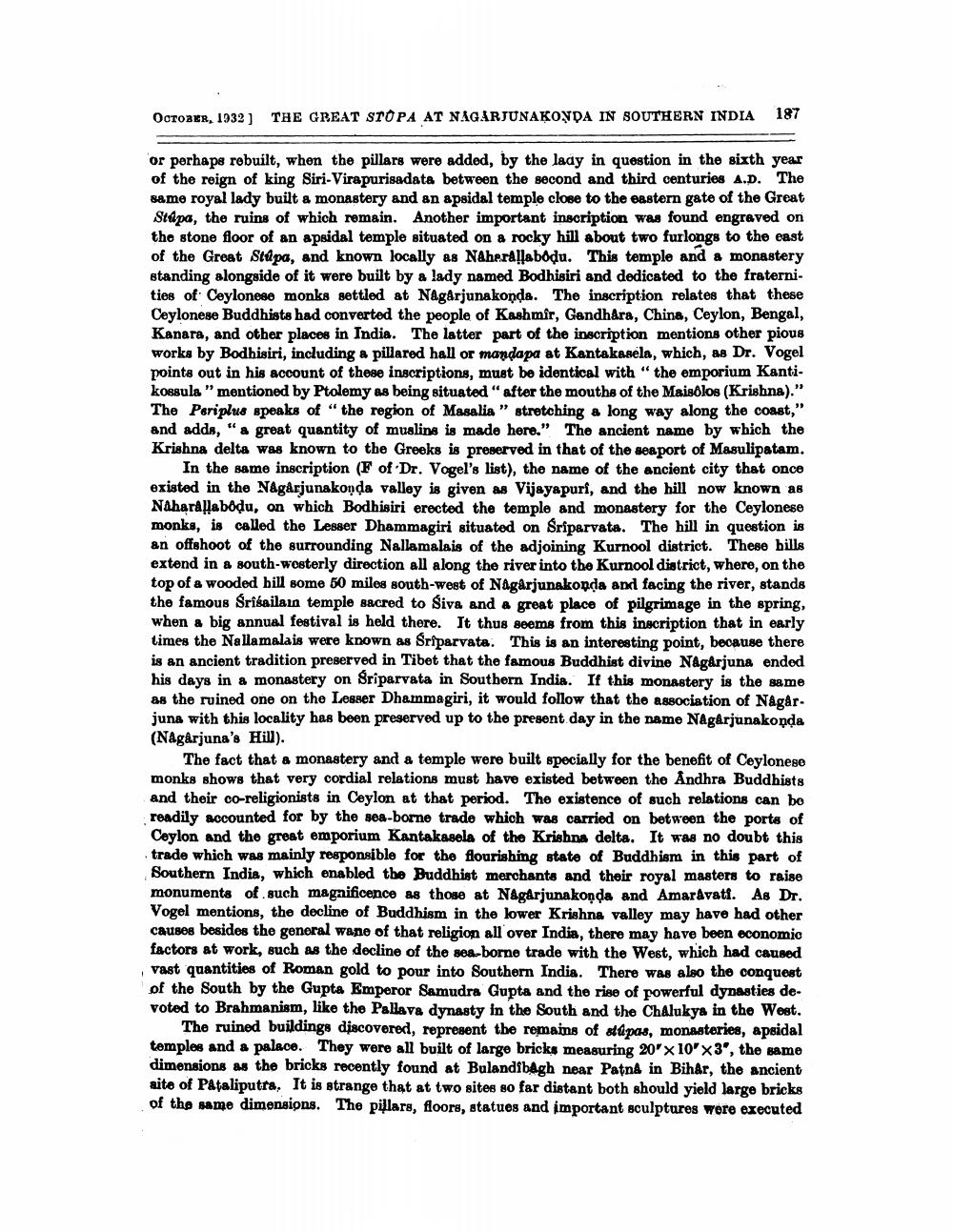________________
OCTOBER, 1932) THE GREAT STOPA AT NAGARJUNAKONDA IN SOUTHERN INDIA
187
or perhaps rebuilt, when the pillars were added, by the lady in question in the sixth year of the reign of king Siri-Virapurisadata between the second and third centuries A.D. The same royal lady built a monastery and an apsidal temple close to the eastern gate of the Great Stapa, the ruins of which remain. Another important inscription was found engraved on the stone floor of an apsidal temple situated on a rocky hill about two furlongs to the east of the Great Stupa, and known locally as NAherallabodu. This temple and a monastery standing alongside of it were built by a lady named Bodhisiri and dedicated to the fraternities of Ceylonese monks settled at Nagarjunakonda. The inscription relates that these Ceylonese Buddhists had converted the people of Kashmir, Gandhara, China, Ceylon, Bengal, Kanara, and other places in India. The latter part of the inscription mentions other pious works by Bodhisiri, including a pillared hall or mandapa at Kantakasela, which, as Dr. Vogel points out in his account of these inscriptions, must be identical with " the emporium Kantikosgula "mentioned by Ptolemy as being situated" after the mouths of the Maisolos (Krishna)." The Periplus speaks of "the region of Masalia " stretching a long way along the coast," and adda, "a great quantity of musline is made here." The ancient name by which the Krishna delta was known to the Greeks is preserved in that of the seaport of Masulipatam.
In the same inscription (F of Dr. Vogel's list), the name of the ancient city that once existed in the Nagarjunakonda valley is given as Vijayapuri, and the hill now known as Naharállabodu, on which Bodhisiri erected the temple and monastery for the Ceylonese monks, is called the Lesser Dhammagiri situated on Sriparvata. The hill in question is an offshoot of the surrounding Nallamalais of the adjoining Kurnool district. These bills extend in a south-westerly direction all along the river into the Kurnool district, where, on the top of a wooded bill some 50 miles south-west of Nagarjunakonda and facing the river, stands the famous Srisailain temple sacred to Siva and a great place of pilgrimage in the spring, when a big annual festival is held there. It thus seems from this inscription that in early times the Nallamalais were known as Sriparvata. This is an interesting point, because there is an ancient tradition preserved in Tibet that the famous Buddhist divine Nagarjuna ended his days in a monastery on Sriparvata in Southern India. If this monastery is the same All the ruined one on the Lesser Dhammagiri, it would follow that the association of Någår. juna with this locality has been preserved up to the present day in the name Nagarjunakonda (Nagarjuna's Hill).
The fact that a monastery and a temple were built specially for the benefit of Ceylonese monks shows that very cordial relations must have existed between the Andhra Buddhists and their co-religionists in Ceylon at that period. The existence of such relations can bo readily accounted for by the sea-borne trade which was carried on between the ports of Ceylon and the great emporium Kantakasela of the Krishna delta. It was no doubt this trade which was mainly responsible for the flourishing state of Buddhism in this part of Southern India, which enabled the Buddhist merchants and their royal masters to raise monuments of such magnificence as those at Nagarjunakonda and Amaravati. As Dr. Vogel mentions, the decline of Buddhism in the lower Krishna valley may have had other causes besides the general wane of that religion all over India, there may have been economic factors at work, such as the decline of the sea-borne trade with the West, which had caused vast quantities of Roman gold to pour into Southern India. There was also the conquest of the South by the Gupta Emperor Samudra Gupta and the rise of powerful dynasties devoted to Brahmanism, like the Pallava dynasty in the South and the Chalukya in the West.
The ruined buildings discovered, represent the remains of aupas, monasteries, apsidal temples and a palace. They were all built of large bricks measuring 20' x 10' X3', the same dimensions as the bricks recently found at Bulandibagh near Patna in Bihar, the ancient aite of Pataliputra, It is strange that at two sites so far distant both should yield large bricks of the same dimensions. The pillars, floors, atatues and important sculptures were executed




